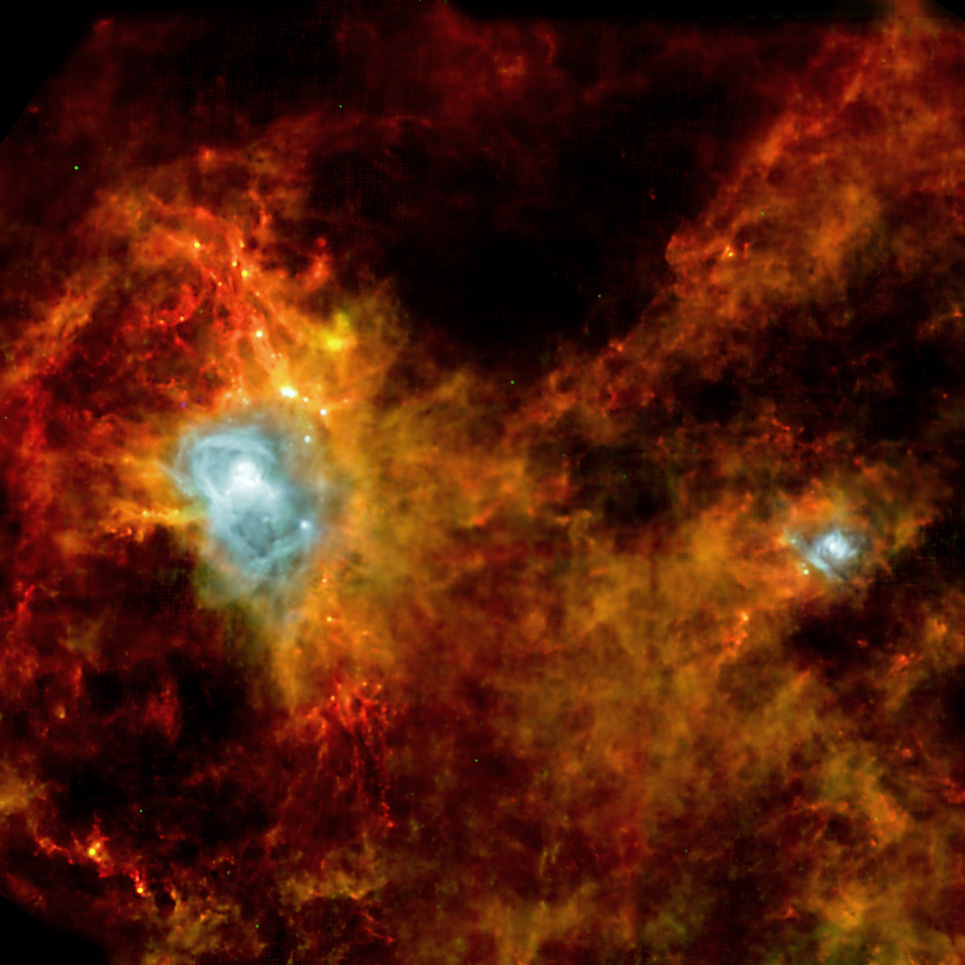| Basic Information | |
| What is this? | A star formation region |
| Where is it in the sky? | In the constellation of Aquila the Eagle |
| How big is it? | About 65 light years across |
| How far away is it? | About 1000 light years away |
| What do the colours represent? | Blue represents hot gas and dust, being warmed by young stars within, while red shows cold dust |
Downloads
See this object in:
A previously unseen stellar nursery comes into view in this Herschel image. Seven hundred newly forming stars are estimated to be crowded into these colourful filaments of dust. The complex is part of a mysterious ring of stars called the Gould Belt.
This image shows a dark cloud located 1000 light years away in the constellation Aquila, the Eagle. It covers an area 65 light years across and is so shrouded in dust that no previous infrared satellite has been able to see into it. Now thanks to Herschel’s superior sensitivity at the longest wavelengths of infrared, astronomers have their first picture of the interior of this cloud.
It was taken on 24 October 2009 using two of Herschel’s instruments: the Photodetector Array Camera and Spectrometer (PACS) and the Spectral and Photometric Imaging Receiver (SPIRE). In this image, 500 micron light from SPIRE is shown in red, while 70 micron and 170 micron light from PACS backs are shown in blue and green respectively. The two bright white regions are areas where large newborn stars are causing the hydrogen gas surrounding them to shine. The redder regions are filaments of colder gas and dust, and the small clumps are denser regions which are collapsing under gravity, and the brighter yellow clumps are warmer and on the way to becoming stars in their own right.
In this image there are about 700 clouds of dust and gas that will eventually become stars. Astronomers estimate that about 100 of these are “protostars”, stars in the final stages of formation. Each one just needs to ignite nuclear fusion in its core to become a true star. The other 600 objects are insufficiently developed to be considered protostars, but these too will eventually become another generation of stars.
This cloud is part of the Gould Belt, a giant ring of stars that circles the night sky because the solar system just happens to lie near the centre of the belt. For more than a hundred years, astronomers have puzzled over the origin of this ring, which is tilted with respect to the plane of our Galaxy by about 20 degrees. The first to notice this unexpected alignment, in the mid-nineteenth century, was John Herschel, son of William Herschel after whom the Herschel telescope is named. It wasn’t until 1874 that the ring was brought to wider attention by Boston-born Benjamin Gould, after whom the belt is named.
The Gould Belt supplies bright stars to many constellations such as Orion, Scorpius and Crux, and is also home to a number of nearby star-forming locations for astronomers to study. Observing these stellar nurseries is a key programme for Herschel, which aims to uncover how star formation starts and proceeds. In particular, astronmers would like to know the quantities of stars that can form and the masses that such newborn stars have. As well as this region of Aquila, Herschel will target fourteen other star-forming regions as part of the Gould Belt Key Programme.
Detailed Information
Gould Belt Survey

